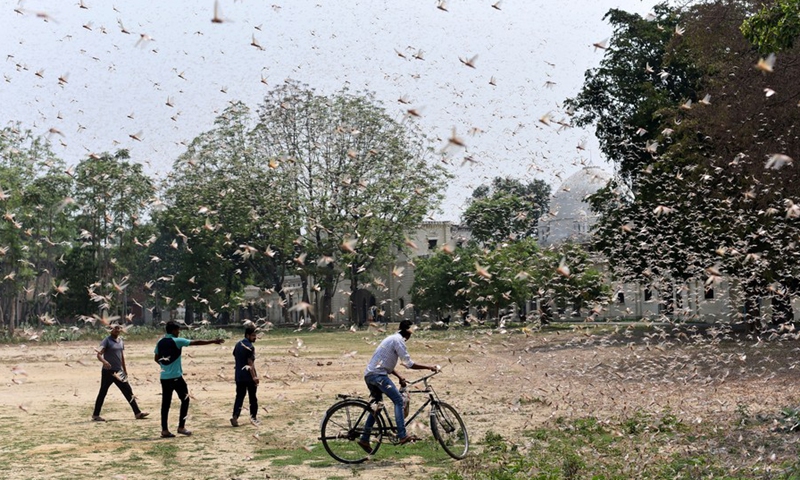China can help India fight desert locust invasion
By Chu Daye Source:Global Times Published: 2020/6/28 20:03:43

Photo taken on June 11, 2020 shows locusts swarming over a field near a residential area in Prayagraj, India's northern state of Uttar Pradesh. (Str/Xinhua)
China could help India to address a locust plague with its emergency response capacity in pest control, although Chinese experts and industry insiders pointed out that the Indian government should create the right conditions for such disaster relief, citing the "boycott China" movement in the country and intentional delays at Indian customs in recent days.
The locust plague has been developing in South Asia since late last year, but it is getting worse in India and swarms of locusts arrived over the weekend at Gurugram, a satellite city of the Indian capital New Delhi.
Being hit at the heart at the country revealed a failure in India's campaign to keep the desert locusts at bay, with some control measures apparently compromised by the economic disruptions of the COVID-19 pandemic, experts said.
He Xiongkui, a professor at the China Agricultural University and an expert in pesticides and specialized equipment, said although India has a large domestic pesticide industry, the country lacks the comprehensive capacity of the Chinese pesticide sector.
"In particular, what we see in the locust attack at New Delhi is India's weak points in emergency response capacity," He said, noting that such capacity involves producing massive amounts of specialist equipment at short notice - a capacity deriving from a well-established industrial chain.
A tractor-mounted sprayer cannon can cover 0.67 square kilometers over five hours. He estimated that the New Delhi city government will need 500-1,000 large, vehicle-based pesticide sprayer cannons to fight the current locust attack.
"If India can't meet such demands, Chinese manufacturers can," He said.
"People need to fight the locusts on the hills, people need to fight them on dry land, and people need to fight them on irrigated fields," said Su Yi, chairman of Beijing-based Sino-agri Leading Biosciences Co. "To do that, people need specialized equipment."
"Ideally, a locust swarm should be ambushed to death along its migration route to the capital, by quickly spraying huge loads of pesticide on crops grown in an entire region that is known to be the locusts' next foraging ground," said Su. "Now that they are already in urban areas of New Delhi, mass spraying poses hazards to people and animals."
"I fear for the fate of the greenery and gardens in New Delhi," Su said.
Indian authorities have reportedly warned local residents to close their windows to keep the locusts away.
"India has a huge gap with China in terms of manufacturing large agricultural machinery, whereas Chinese makers of such specialist equipment can effectively close these gaps," said Zhang Zhishi, general manager of Shandong Province-based Huasheng Zhongtian, a leading pesticide machinery maker.
Huasheng sells a wide range of pesticide sprayers from tractor-based giant sprayers to the more usual lightweight models that can be carried by a single person, with prices ranging from $20 to $1 million.
"The problem is, India has long been placing curbs on Chinese products, carrying out a 'politics first' stance toward trade with China," Zhang said.
Beyond the India's media fanning of the flames with calls to boycott Chinese products, the Indian customs authority is reportedly putting some containers from China on hold for intensive inspection amid recent bilateral tensions.
A small swarm of desert locusts eats as much in one day as about 35,000 people, according to the UN Food and Agriculture Organization. Locusts can also travel 150 kilometers a day.
Posted in: INDUSTRIES,ECONOMY